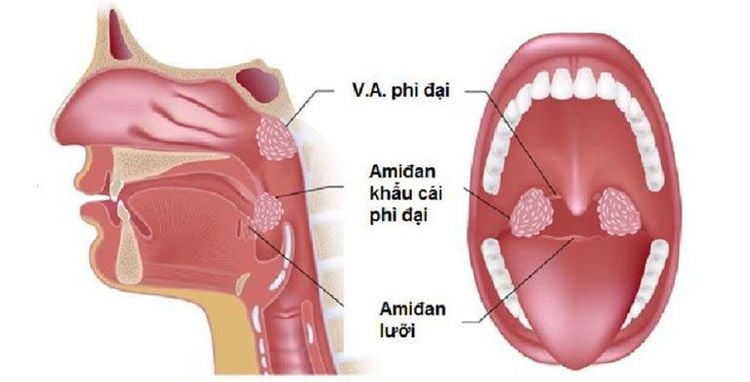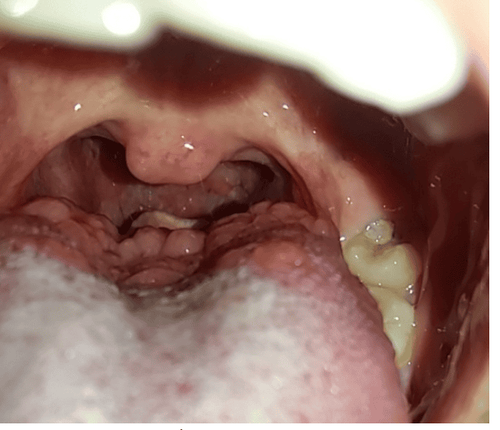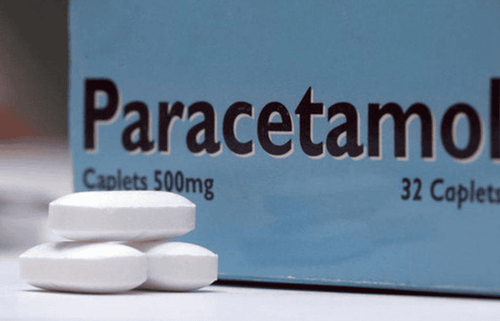This is an automatically translated article.
The article was professionally consulted by Specialist Doctor of Otolaryngology - Department of Medical Examination and Internal Medicine - Vinmec Hai Phong International Hospital.
Tongue tonsillitis is a condition in which the tongue tonsils are invaded by bacteria or viruses, causing inflammation, swelling, pain, and burning in the tongue area. Treatment of tonsillitis needs to be done early to prevent complications as the infection spreads.
1. What is tongue tonsillitis?
Tongue tongue is a lymphoid tissue located at the base of the tongue behind the V tongue. This is a part of the Waldeyer ring of the airway lymphatic system, which plays a role in maintaining the immune system, helping the body fight pathogens. Tonsillitis is a condition in which the tongue tonsils are invaded by bacteria or viruses, causing inflammation, pain, and burning in the tongue. Picture of tongue tonsillitis in common patients is:
Large swollen tonsils: When observing the base of the tongue, the tonsils will be swollen and red. The surface of the tonsils may appear white dots of pus. The throat area is red, swollen, dry, red throat mucosa, discharge, dirty white tongue, swollen lymph nodes behind the throat. Patients with fever, prolonged cough, hoarseness, chest pain, wheezing while sleeping. Tonsillitis often occurs in:
People with poor oral hygiene, with oral diseases such as tooth decay, gingivitis, V.A., sinusitis, .. People with respiratory diseases who are not treated thoroughly. In order for the bacteria to grow, it spreads to the tonsils of the tongue, causing inflammation. People with poor resistance, weakened immune system, bacteria and viruses easily attack and cause disease. Polluted environment, erratic weather changes, and allergies are also favorable factors for the occurrence of the disease.

If the treatment of tonsillitis is not done or is not done thoroughly, the tonsillitis at the base of the tongue can progress to a chronic condition, which is difficult to treat, and at the same time causes many dangerous complications for the patient. Possible complications are:
Local complications: Tonsillitis fissure, inflammation around the tonsils, tonsil stones, inflammation of the side of the throat, chronic pharyngitis. Proximal complications: Chronic cervical lymphadenitis, otitis media, rhinosinusitis, laryngitis, tracheitis, bronchitis. Distant complications: Arthritis, endocarditis, glomerulonephritis, sepsis,... Once complications have occurred, the treatment will become much more difficult and expensive, while the condition Health is not necessarily fully recovered. Therefore, in order to facilitate treatment and limit possible risks, patients should go to medical facilities for examination as soon as they have the first symptoms of the disease.

2. How to treat tongue tonsillitis?
When visiting medical facilities, the doctor will conduct a clinical examination and prescribe a number of tests such as a blood count test, nasopharyngoscopy, taking samples from the cultured lesion area. to determine the cause of the disease. The results from these tests will help your doctor make a diagnosis and find the most effective treatment for you.
In acute tonsillitis, if the cause is a virus, the main treatment is to treat symptoms, improve physical condition, antibiotics are used only when the cause is bacteria or threatens complications.
In case of severe infection, the doctor may prescribe a combination of antibiotics between different groups. The treatment with antibiotics should strictly follow the instructions of the doctor, not stop when the symptoms of the disease subside. The inappropriate use of antibiotics can lead to the risk of antibiotic resistance.
Commonly used drugs to treat symptoms are:
Antipyretics, analgesics: Paracetamol Anti-inflammatory drugs: Methylprednisolone, Prednisolone Local treatment: regularly rinse mouth with physiological saline 0.9% NaCl or solution warm lye solution (mix half a teaspoon of sodium bicarbonate, sodium borate,... in a cup of warm water to gargle).

For the treatment of chronic tongue tonsillitis, if medical treatment is not effective, the disease often recurs (5-6 times/year), the tonsils of the tongue actually become an inflammatory foci of harm to the body, causing For complications, the doctor may appoint a tongue tonsillectomy for the patient. The tonsillectomy methods that can be used are:
Laparoscopic surgery Tonsillectomy with Sluder- Ballenger Instrumentation Laser tonsillectomy Coblator method Each method has its own advantages and disadvantages, the doctor will consult with the patient. Select the appropriate surgical method.
3. Care regimen while treating tongue tonsillitis
In addition to following treatment instructions for quick recovery, during the treatment of tonsils on the tongue, the patient needs to spend a lot of time resting, increasing nutrition, and drinking plenty of filtered water. It is advisable to prepare soft, easy-to-swallow foods and divide them into several meals a day. Gargling with salt water daily helps to disinfect, soothe pain and prevent the risk of mouth and throat infections.
If the tongue tonsils are treated with surgery, after two weeks of tonsillectomy, the patient should maintain a soft and liquid diet such as milk, porridge, noodles, soup. When the sore throat is relieved, you can gradually switch to eating pasty rice. Limit communication, do not scream, run, jump, do heavy work or do heavy physical exercise during this time.

To register for examination and treatment at Vinmec International General Hospital, you can contact Vinmec Health System nationwide, or register for an online examination.













